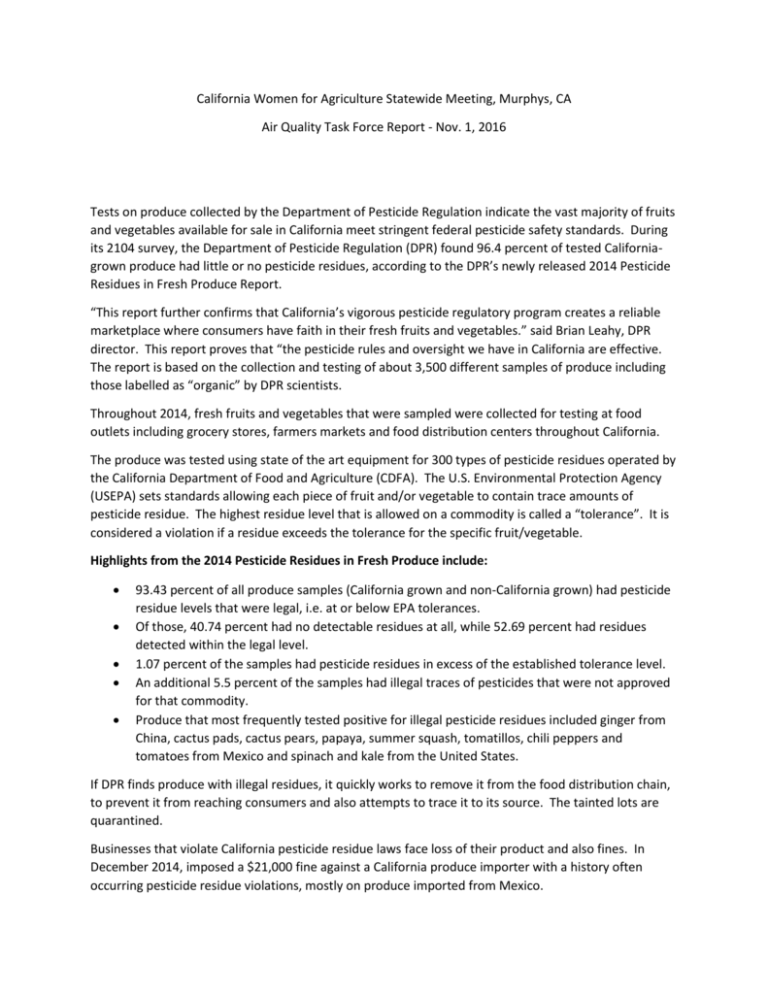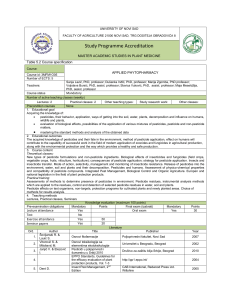California Women for Agriculture Statewide Meeting, Murphys, CA
advertisement

California Women for Agriculture Statewide Meeting, Murphys, CA Air Quality Task Force Report - Nov. 1, 2016 Tests on produce collected by the Department of Pesticide Regulation indicate the vast majority of fruits and vegetables available for sale in California meet stringent federal pesticide safety standards. During its 2104 survey, the Department of Pesticide Regulation (DPR) found 96.4 percent of tested Californiagrown produce had little or no pesticide residues, according to the DPR’s newly released 2014 Pesticide Residues in Fresh Produce Report. “This report further confirms that California’s vigorous pesticide regulatory program creates a reliable marketplace where consumers have faith in their fresh fruits and vegetables.” said Brian Leahy, DPR director. This report proves that “the pesticide rules and oversight we have in California are effective. The report is based on the collection and testing of about 3,500 different samples of produce including those labelled as “organic” by DPR scientists. Throughout 2014, fresh fruits and vegetables that were sampled were collected for testing at food outlets including grocery stores, farmers markets and food distribution centers throughout California. The produce was tested using state of the art equipment for 300 types of pesticide residues operated by the California Department of Food and Agriculture (CDFA). The U.S. Environmental Protection Agency (USEPA) sets standards allowing each piece of fruit and/or vegetable to contain trace amounts of pesticide residue. The highest residue level that is allowed on a commodity is called a “tolerance”. It is considered a violation if a residue exceeds the tolerance for the specific fruit/vegetable. Highlights from the 2014 Pesticide Residues in Fresh Produce include: 93.43 percent of all produce samples (California grown and non-California grown) had pesticide residue levels that were legal, i.e. at or below EPA tolerances. Of those, 40.74 percent had no detectable residues at all, while 52.69 percent had residues detected within the legal level. 1.07 percent of the samples had pesticide residues in excess of the established tolerance level. An additional 5.5 percent of the samples had illegal traces of pesticides that were not approved for that commodity. Produce that most frequently tested positive for illegal pesticide residues included ginger from China, cactus pads, cactus pears, papaya, summer squash, tomatillos, chili peppers and tomatoes from Mexico and spinach and kale from the United States. If DPR finds produce with illegal residues, it quickly works to remove it from the food distribution chain, to prevent it from reaching consumers and also attempts to trace it to its source. The tainted lots are quarantined. Businesses that violate California pesticide residue laws face loss of their product and also fines. In December 2014, imposed a $21,000 fine against a California produce importer with a history often occurring pesticide residue violations, mostly on produce imported from Mexico. The DPR continues to find small but insignificant number of cases of illegal residues on fresh produce from Mexico and other countries outside the U. S. To help address this, the DPR enforcement staff gave presentations about DPR Pesticide Residue Monitoring Program to about 160 Mexican fruit and vegetable growers at workshops in Mexicali and Ensenada. The 2014 pesticide residue monitoring data is posted at http://www.cdpr.cagov/docs/enforce/residu/rsmonmnu.htm California Used Less Fumigant and Carcinogenic Pesticides in 2013 California used fumigants and carcinogenic pesticides in 2013 than the previous year, according to data in the Annual Summary of Pesticide Use. “Information is a key ingredient in a vigorous regulatory program to protect human health and the environment. The date shows California is reducing the use of some of the most toxic pesticides, but continuing to control pests that, if unchecked, would cause disease, threaten public health and affect our food supply“, said DPR Director Brian Leahy. “I believe the Pesticide Use Report is the best of its kind in the world and is produced for regulators and researchers to help them understand how pesticide use impacts human health and the environment. If misused, pesticides can be harmful. To combat the potential for harmful impacts, DPR has developed the most comprehensive and protective regulatory program in the nation to protect people and the environment. The 2013 report shows the following reductions, compared to the previous year: Use of pesticides that could contaminate ground water decreased by 246,000 pounds (23 percent) Use of pesticides with the potential to pollute the air decreased by 2.4 million pounds (4.9 percent) Use of fumigant pesticides decreased by 2.2 million pounds (4.9 percent) Use of carcinogenic pesticides decreased by 1.7 million pounds (5.1 percent) California alone produces nearly half of American grown fruits, nuts and vegetables and depending upon pest problems, weather, acreage and other factors, the amount of pesticides use varies from year to year. Despite a reduction in the pesticide categories listed above, the total amount of pesticides used in agriculture increased by 6.4 million pounds to a total of 178 million pounds (3.7 percent). Including other application such as mosquito control or pest protection in residential and commercial buildings, the overall amount of pesticide used in California in 2013 totaled 194 million pounds, an increase of 6.9 million pounds. The 2013 Annual Pesticide Report was published by DPR in May 2015 Additional Resources: California Department of Pesticide Regulation 2012-2014 Progress Report and Air Monitoring Network Results for 2014 – Volume 4, October 2015 Report submitted by Roberta Alderete, Santa Maria Chapter, ralderete@unitedag.org, cell 805-878-1603







